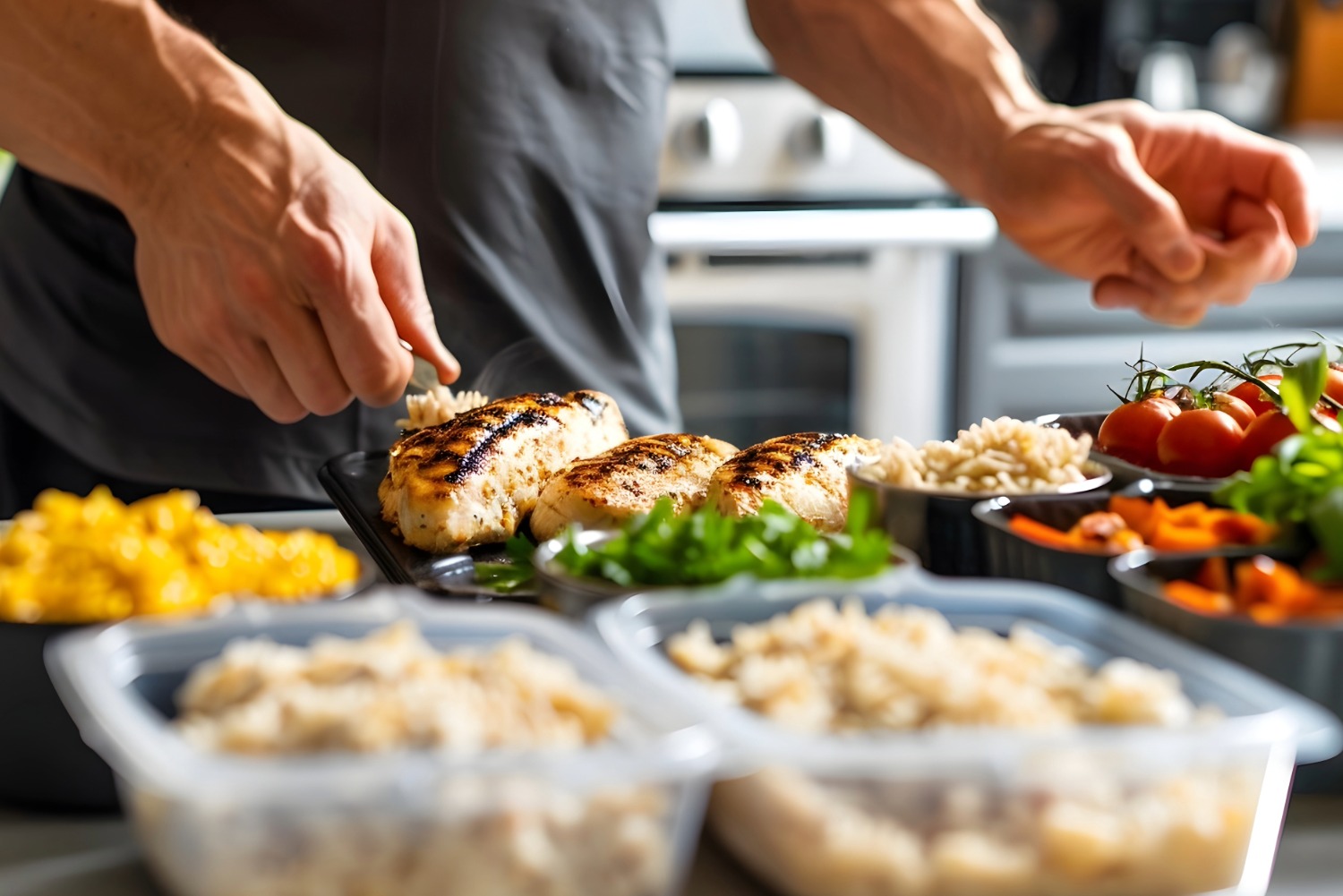News
Nourishing Medicine
Getting sick or having an accident that results in surgery is a major life event. But sometimes a stay in the hospital is just the beginning of what can be a long road to recovery. Being laid up at home fragile and tired can be difficult and seem interminable.
There's a reason chicken noodle soup is used almost medicinally when people are under the weather it's both comforting and nutritious the perfect balance for someone in recovery. Because no matter how skilled the surgeons are a body needs food.
Food is required for energy says Shaw Regional Cancer Center oncology dietitian Melaine Hendershott. It's baseline. We need energy to make our brains work to make our muscles contract to make our bodies work. That energy comes in the form of carbohydrates fats and protein. So food is vital to life. Those are our macronutrients.
But food can also deliver micronutrients which show improved performance in a variety of ways. For instance calcium makes bones strong and has been linked with decreased risk of heart attack. That makes it fairly attractive as a supplement a nutrient that can be ingested in pill or liquid form instead of by eating foods that include the vitamins and minerals. But there's something tricky about trying to take a shortcut and bypass the food.
You might see improved performance when you eat foods high in vitamin C vitamin A fiber and calcium but often you get worse outcomes when you take those as supplements. Most recently a study showed that people who took high doses of calcium supplements resulted in an increased risk of heart attack and kidney stones yet those same high doses if eaten in food didn't increase those risks.
Why would it make a difference? There is something about eating it in foods that means our bodies tend to use it she explains.
This doesn't mean all supplements are bad simply that they should be taken in moderation. And it's always a good idea to review a supplement plan with a doctor dietitian or pharmacist.
Certain groups of the population should take particular supplements such as pregnant and lactating women: prenatal vitamins have the nutrients they need when their bodies need it the most.
But for the most part the best way to get good nutrition is by using a fork and knife.
What to cook if someone is recovering from surgery:
Incorporate a protein with every snack and meal. People who've just undergone surgery will want to eat lots of small meals spaced throughout the day rather than a couple large ones.
Protein is important for healing and regeneration of cells Hendershott says. So if you're trying to heal your body's metabolism is higher. And if you're not eating adequate protein and calories it will take what it needs from your muscles. That means more lean-body mass loss. It's good to have extra protein and plenty of hydration.
Had their gall bladder removed:
People who have had their gall bladders removed should eat a low-fat diet in
general for life.
Your gall bladder is used to push bile into your small intestine she says. It emulsifies the fat you eat and helps you pull it into your blood stream. That enables it to be passed around your cells for energy.
When the gall bladder is removed the bile duct is reattached to the small intestine. So the body is able to metabolize and use some fat but not a lot at a time. Hendershott recommends eating small frequent low-fat meals otherwise people might experience bloating and pain.
Going through cancer treatment:
A healthy well-balanced diet is important.
There are side effects that affect your eating Hendershott says. Chemotherapy can reduce your immune system so you want good food-safety practices like cooking meats to the proper temperature and washing your hands fruits and veggies.
Even those who don't feel like eating should try to eat a little because it's key to prevent weight loss and muscle loss.
Also if you're suffering from fatigue try to incorporate some small exercise into the day like a short walk she says. That will help with fatigue.
Has heart disease:
Heart disease also dictates a low-fat low-saturated-fat diet. Another key element is increased exercise.
Casseroles are high in fat so avoid those for people with heart disease. Whole-grain pastas with tomato sauce and lots of veggies would be good. Soups are broth-based and can have lean meats like chicken breasts or ground turkey or just beans so those are good too.
The trick is to have lots of flavor so nobody feels deprived yet not load up on the fat.
MELAINE HENDERSHOTT'S FAVORITE SNACKS
Easy Granola Cookies
3 bananas
1 cup walnuts
1 cup figs
1 teaspoon vanilla
2 cups oatmeal
1 cup dates soaked in water for 20 minutes then drained
1. Preheat oven to 350 degrees.
2. Process all ingredients except oatmeal in a food processor until smooth. Add oatmeal and combine well.
3. Drop by spoonfuls onto a baking sheet and bake for 10 to 12 minutes or until lightly browned.
Baked Chips
Whole Wheat Tortillas
Cooking Spray
Salt
1. Preheat oven to 350.
2. Cut tortillas into chips.
3. Spray both sides of tortillas on a baking sheet and sprinkle with salt.
4. Bake until golden brown rotating the baking sheet once about 12 to 15 minutes.
Guacamole
Avocados are a superfood loaded with potassium iron vitamins A C E B-complex fiber and heart healthy fats (monounsaturated fats). They're also the perfect baby food on the go as you can just slice one in half and offer spoonfuls to your baby without any mess or prep.
3 Hass avocados halved seeded and peeled
1 lime juiced
½ teaspoon kosher salt
½ teaspoon cumin ground
½ teaspoon cayenne
½ onion diced
2 roma tomatoes seeded and diced
1 tablespoon cilantro chopped
1 clove garlic minced
Baked chips (recipe prior)
1. In a large bowl place the scooped avocado pulp and lime juice toss to coat making sure you get all of them.
2. Drain reserving lime juice.
3. Add the salt cumin and cayenne and mash with a potato masher or a fork.
4. Fold in the onions tomatoes cilantro and garlic. Add 1 tablespoon of the reserved lime juice. Let sit at room temperature for 1 hour and then serve.
NUTRITION FACTS
Guacamole
Serves 8 Serving Size (85g) Amount Per Serving: Calories 95 Calories from Fat 66 Total Fat 8g (8% DV) Saturated Fat 1g (5% DV) Trans Fat 0g Cholesterol 0mg (0% DV) Sodium 160mg (7% DV) Total Carbohydrate 7g (3% DV) Dietary Fiber 4 g (16% DV) Sugars 1g Protein 1g Vitamin A 5% Vitamin C 17% Calcium 1% Iron 2%
Baked Chips
Serving Size (24g) Amount Per Serving: Calories 70 Calories from Fat 15 Total Fat 2g (3% DV) Saturated Fat 0g (0% DV) Trans Fat 0g Cholesterol 0mg (0% DV) Sodium 160mg (7% DV) Total Carbohydrate 11g (4% DV) Dietary Fiber 2g (8% DV) Sugars 1g Protein 1g Vitamin A 0% Vitamin C 0% Calcium 0% Iron 4%
Easy Granola Cookies
Serves 12 Serving Size 2 cookies Amount Per Serving: Calories 201 Calories from Fat 56 Total Fat 7g (11% DV) Saturated Fat 1g (5% DV) Trans Fat 0g Cholesterol 0mg (0% DV) Sodium 2mg (0% DV) Total Carbohydrate 35g (13% DV) Dietary Fiber 5g (20% DV) Sugars 18g Protein 4g Vitamin A 1% Vitamin C 5% Calcium 4% Iron 7%
More News
-
New!
More

Screening Secrets: What Every Man Should Know About Prostate Cancer Screening
Prostate cancer is the most common type of non-skin related cancer in men, and it is the second leading cause of cancer-related deaths in men within the United States, behind lung cancer. Fortunately, if caught early, prostate cancer remains highly treatable and curable with minimally invasive procedures.
-
New!
More

Unplug to Recharge: Why a Digital Detox Is the Real Power Move for 2026
Our phones promise connection, convenience and control, yet most of us feel more scattered, stressed and sleepless than ever. The constant pings, scrolls and notifications have rewired our brains for distraction. The fix? Not abandoning technology altogether, but reclaiming balance.
-
New!
More

Beyond the Scale: Why Nutrition and Exercise Work Better Together
For decades, weight loss advice has been distilled into a simple equation: calories in, calories out. Eat less, maybe combine that with exercise, and the pounds will fall away. But according to experts at Vail Health, that equation overlooks a much bigger picture.





